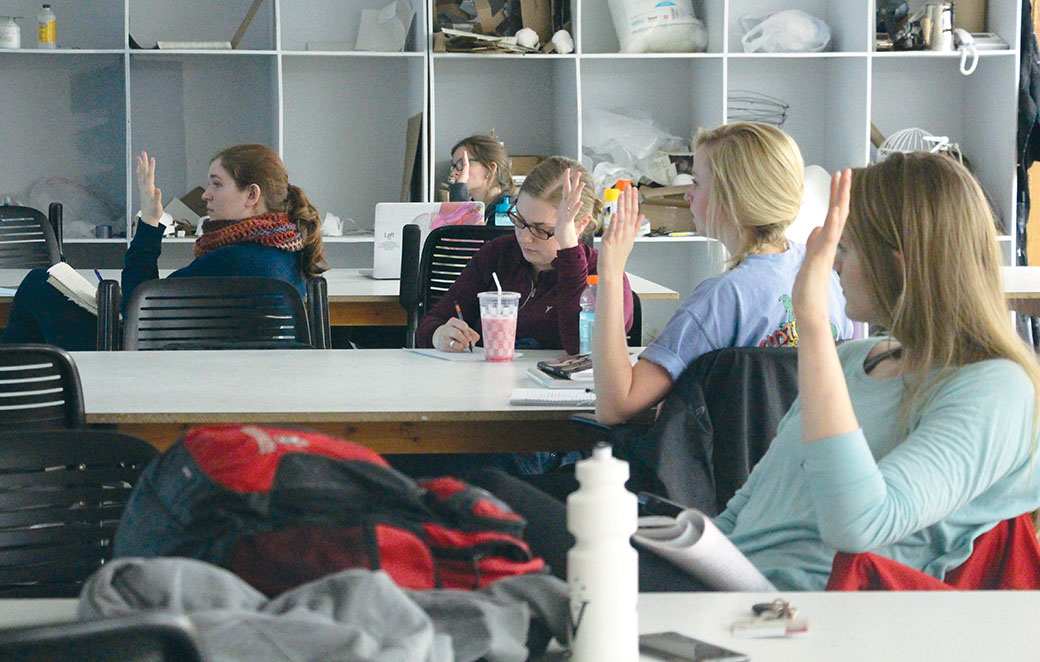
Art therapy, arts in health programs seeing increased interest at USD
Two USD art alumni are bringing their passion for art therapy and arts in health to current students.
Alison Boughn, a doctoral student and art therapist, and Ariadne Albright, program coordinator for Sanford Arts Vermillion, were both interested in art therapy and came together to create courses for USD students interested in the fields.
“We both have a common goal that we want to help bring the arts to our community and we see the value in it,” Boughn said. “I think when you have someone that aligns with your passions, you stick with that person.”
Art therapy helps with senses and how people interact in the world in sensory ways, Boughn said.
“Art therapy is engaging the brain in a way that focuses on sensory-based modalities to solve physiological or psychological manifestations of those concerns,” she said.
Senior painting major Rebecca Froehlich is in Boughn’s course and has had internships in arts in health.
“I believe people are innately creative and a lot of them lose track of that when they get older and become more critical of themselves,” she said. “Arts in health affects people of all age groups and can reintroduce them to creative processes that they lost.”
Albright said she had a workshop on arts in health to artists and administrators at Sanford Arts in Aberdeen, where there was an interest in having a four-course program to start out. The first course was a general survey in arts in healthcare.
Boughn teaches the second USD course in art therapy, which focuses on arts and health multiculturalism populations and ethics. The class has seven students and meets once a week for three hours.
“It provides students that opportunity to learn these systems that exist in our world and how they are part of them,” she said. “We teach students when you need to refer to an art therapist, or is this something that you can handle. The class that we have right now focuses on kind of identifying those pieces and how everything works together and when to refer out.”
The third course is about materials used in safety, which Albright will be teaching in the fall. The fourth class in this certificate program is an internship.
Boughn and Albright said they work well together because they are from two different fields — Boughn works in art therapy and Albright is a fine artist who works in healthcare.
Albright said these two fields are “compatible but different.”
“What I think is so valuable about collaborating with Ali is her training targets specific behaviors in a clinic way, and whereas I am very invested in materials, process and personal expression,” Albright said. “It takes the two of us to navigate through healthcare environments in safe ways. It’s really important to us when we work with students that we keep those boundaries clear.”
Albright has also had several student interns working with her at Sanford Arts Vermillion.
“I’ve been blessed with some outstanding interns over these years who come in for a semester’s time and serve, learn about the field, work with the geriatric community and also the staff,” she said.
Froehlich has worked with dementia patients, people in cancer centers and others in the healthcare setting. She said these courses help with preparation for going into the field.
“I definitely hope to make this my career,” she said. “Gaining theoretical knowledge and then applying it is a better process than getting thrown in there and learning. When it comes to things that are really sensitive, like working with vulnerable patients, it’s better to be prepared.”
Boughn said she wants art therapy to benefit her students and the rest of the world.
“Art therapy is that tool that’s missing from our world,” Boughn said. “It’s our responsibility to help the Midwest generate this understanding of the field and its effectiveness.”
Correction: The Volante incorrectly quoted Rebecca Froehlich saying “I believe people are innately created,” and not “I believe people are innately creative.” The Volante regrets this error.

